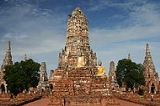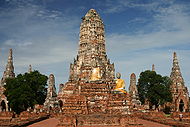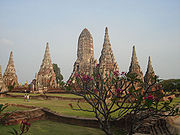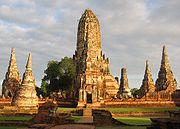
Wat Chaiwatthanaram
Encyclopedia

Buddhism
Buddhism is a religion and philosophy encompassing a variety of traditions, beliefs and practices, largely based on teachings attributed to Siddhartha Gautama, commonly known as the Buddha . The Buddha lived and taught in the northeastern Indian subcontinent some time between the 6th and 4th...
temple in the city of Ayutthaya
Ayutthaya historical park
The Ayutthaya historical park covers the ruins of the old city of Ayutthaya, Thailand, which was founded by King Ramathibodi I in 1350 and was the capital of the country until its destruction by the Burmese army in 1767....
, Thailand
Thailand
Thailand , officially the Kingdom of Thailand , formerly known as Siam , is a country located at the centre of the Indochina peninsula and Southeast Asia. It is bordered to the north by Burma and Laos, to the east by Laos and Cambodia, to the south by the Gulf of Thailand and Malaysia, and to the...
, on the west bank of the Chao Phraya River, outside Ayutthaya island. It is one of Ayutthaya's best known temples and a major tourist attraction.
Location
Wat Chaiwatthanaram lies on the west bank of Chao Phraya RiverChao Phraya River
The Chao Phraya is a major river in Thailand, with its low alluvial plain forming the centre of the country. It runs through Bangkok, the capital city, and then empties into the Gulf of Thailand.-Etymology:...
, south west of the old city of Ayyuthaya. It is a large compound and is a UNESCO
UNESCO
The United Nations Educational, Scientific and Cultural Organization is a specialized agency of the United Nations...
World Heritage Site
World Heritage Site
A UNESCO World Heritage Site is a place that is listed by the UNESCO as of special cultural or physical significance...
. It can be reached by road or by boat.
History
The temple was constructed in 1630 by the king Prasat ThongPrasat Thong
King Prasat Thong was the first king of Prasat Thong dynasty, the 4th dynasty of Ayutthaya kingdom. He was the Defense minister of King Songtham....
as the first temple of his reign, as a memorial of his mother's resident in that area. The temple's name literally means the Temple of long reign and glorious era. It was designed in Khmer
Khmer people
Khmer people are the predominant ethnic group in Cambodia, accounting for approximately 90% of the 14.8 million people in the country. They speak the Khmer language, which is part of the larger Mon–Khmer language family found throughout Southeast Asia...
style which was popular in that time.
It has a central 35 meter high prang
Prang
Prang may refer to:*: an airplane crash*Ernie Prang , a character in the Harry Potter stories*Prang, an art supply brand of Dixon Ticonderoga*Prang , a type of South-East Asian temple spire...
in Khmer style (Thai: พระปรางด์ประธาน) with four smaller prangs. The whole construction stands on a rectangular platform. About halfway up there are hidden entrances, to which steep stairs lead.
The central platform is surrounded by eight chedi
Stupa
A stupa is a mound-like structure containing Buddhist relics, typically the remains of Buddha, used by Buddhists as a place of worship....
-shaped chapels (Thai: เมรุทิศ เมรุราย - Meru Thit Meru Rai), which are connected by a rectangular cross-shaped passage (Phra Rabieng). The passage had numerous side entries and was originally roofed and open inwards, but today only the foundations of the pillars and the outside wall still stand. Along the wall, there were 120 sitting Buddha
Buddha
In Buddhism, buddhahood is the state of perfect enlightenment attained by a buddha .In Buddhism, the term buddha usually refers to one who has become enlightened...
statues, probably painted in black and gold.
The eight chedi-like chapels are formed in a unique way. They had paintings on the interior walls, the exterior ones decorated by 12 reliefs depicting scenes from the life of Buddha (Jataka), which must be "read" clockwise. Just fragments of the paintings and the reliefs survived. In each of the rectangular chedis were two sitting Buddha statues and in each of the four middle chedis was one big sitting Buddha statue, also lacquered in black and gold. The ceiling over those statues was of wood with golden stars on black lacquer.
Outside of the passages on the east, close to the river was the temple's ordination hall (Phra Ubosot). North and south from the Ubusot stood two chedis with "12 indented corners" (Thai: เจดีย์อมุมสิบสอง), in which the ashes of the king's mother were laid.
After the total destruction of the old capital (Thai: กรุงเก่า - Krung Kao) by the Burmese in 1767, from which Wat Chai Watthanaram was not spared, the temple was deserted. Theft, sale of bricks from the ruins and the beheading of the Buddha statues were common. Only in 1987 did the Thai Department of Fine Arts start restoring the site. In 1992 it was opened to the public.
Usage
Wat Chaiwatthanaram was a royal temple where the king and his successors performed religious ceremonies. Princes and princess were cremated here, including King Boromakot's son Chaofa Thammathibet (เจ้าฟ้าธรรมธิเบศร).Symbolic
The Wat Chaiwatthanaram structure reflects the Buddhist world view, as it is described already in the Traiphum Phra Ruang, the "three worlds of the King Ruang", of the 14th century:The big "Prang Prathan" that stands in the centre symbolizes the mountain Meru (Thai: เขาพระสุเมรุ - Khao Phra Sumen), which consists the central axis of the traditional world (Kamaphum - กามภูมิ). Around it lie the four continents (the four small Prangs) that swim in the four directions in the world sea (นทีสีทันดร). On one of the continents, the Chomphutawip (ชมพูทวีป), the humans live. The rectangular passage is the outer border of the world, the "Iron Mountains" (กำแพงจักรวาล).
Images
{||

|



